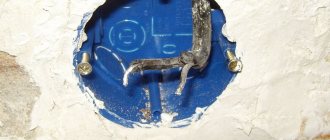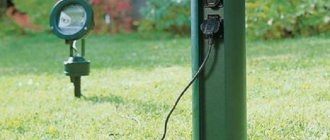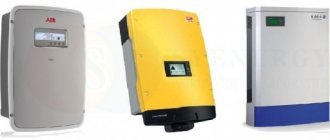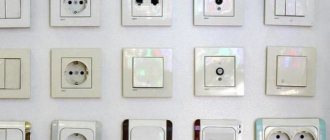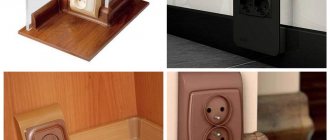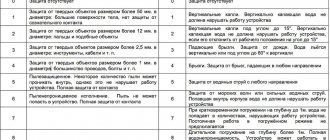Electrical installation devices
6.6.21. The requirements given in paragraphs. 6.6.22-6.6.31, apply to devices (switches, switches and sockets) for rated current up to 16 A and voltage up to 250 V, as well as plug connections with protective contact for rated current up to 63 A and voltage up to 380 V .
6.6.22. Devices installed hidden must be enclosed in boxes, special casings, or placed in holes in reinforced concrete panels formed during the manufacture of panels at construction industry factories. The use of flammable materials for the manufacture of covers covering openings in panels is not allowed.
6.6.23. Socket outlets installed in locked storage areas containing flammable materials or materials in flammable packaging must have a degree of protection in accordance with the requirements of Chapter. 7.4.
6.6.24. Plug sockets for portable electrical receivers with parts subject to protective grounding must be equipped with a protective contact for connecting a PE conductor. In this case, the design of the socket must exclude the possibility of using current-carrying contacts as contacts intended for protective grounding.
The connection between the grounding contacts of the plug and the socket must be established before the current-carrying contacts come into contact; the shutdown order should be reversed. The grounding contacts of socket outlets and plugs must be electrically connected to their housings if they are made of conductive materials.
6.6.25. Plug connectors must be designed in such a way that they cannot be plugged into socket outlets with a higher rated voltage than the rated voltage of the plug. The design of sockets and plugs should not allow the inclusion of only one pole of a two-pole plug, as well as one or two poles of a three-pole plug, into the socket.
6.6.26. The design of plug connectors must prevent tension or breakage of the wires connected to them at the connection points.
6.6.27. Switches and switches for portable electrical receivers should, as a rule, be installed on the electrical receivers themselves or in electrical wiring laid fixedly. On moving wires it is allowed to install only switches of a special design intended for this purpose.
6.6.28. In three- or two-wire single-phase lines of networks with a grounded neutral, single-pole switches can be used, which must be installed in the phase wire circuit, or two-pole ones, and the possibility of disconnecting one neutral working conductor without disconnecting the phase conductor must be excluded.
6.6.29. In three- or two-wire group lines of networks with an insulated neutral or without an insulated neutral at voltages above 50 V, as well as in three- or two-wire two-phase group lines in a 220/127 V network with a grounded neutral in rooms with increased danger and especially dangerous ones, they should be installed double pole switches.
6.6.30. Socket outlets must be installed:
1. In industrial premises, as a rule, at a height of 0.8-1 m; When supplying wires from above, installation at a height of up to 1.5 m is allowed.
2. In administrative, office, laboratory, residential and other premises at a height convenient for connecting electrical appliances to them, depending on the purpose of the premises and interior design, but not higher than 1 m. It is allowed to install plug sockets in (on) specially adapted for this skirting boards made of non-combustible materials.
3. In schools and child care institutions (in premises for children) at a height of 1.8 m.
6.6.31. Switches for general lighting fixtures should be installed at a height of 0.8 to 1.7 m from the floor, and in schools, nurseries and kindergartens in rooms for children - at a height of 1.8 m from the floor. It is possible to install switches under the ceiling with cord control.
Three-pole sockets
380 volt sockets are made three-pole - one pole per phase. Almost all of these sockets are grounded; according to the new rules, this is mandatory. The 380 socket is made much more durable, using non-flammable materials.
A fire resulting from a short circuit in such an outlet is very impressive, since significantly greater power is transmitted in three-phase circuits than in single-phase circuits. Almost every three-phase outlet is external. All 380 V sockets are sealed with rubber bushings and gaskets to prevent moisture and dust from getting inside.
Design features and technical characteristics
In terms of design, there are recessed and external type devices. In the first case, there is no socket box, and overhead devices include a mounting panel. Recessed devices are used for hidden wiring (they look aesthetically pleasing). Outdoor type devices are mounted on an open network route.
Plug sockets are marked with numbers and letters. For example: RSh-Ts – 20-0-01-10/220 – this is a recessed type electrical socket for open wiring, single-phase, with grounding, used for a network with a voltage of 220V and a frequency of 50 Hz.
The documentation for each device must indicate the rated and limiting currents and voltages, the number of contacts, poles, degree of protection and climatic requirements.
Small-sized model RS-16-006 hidden installation
The socket is two-pole. Single hidden installation. There is no grounding. The diameter of the plug pins is 4 or 4.8 mm.
The invoice device is white, made of matte plastic. Rated voltage 250 V, rated current 16 A. Protection degree IP20, climatic version UHL4.
Plug socket PS-326-100 (IEK brand)
PS-326-100 recessed type for open wiring. Rated current 40 A, voltage 24V. Number of contacts 7. Suitable for VAZ, KAMAZ trailers, etc.
Low voltage socket 42V RP-2B
Waterproof recessed type model for hidden wiring, degree of protection IP43, rated voltage 42 V, current 10 A. Climatic operating conditions UHL, number of poles 2.
Neutral small-sized type NMSh
NMS are used to connect high-power circuits and are electromagnetic type devices. The installation diagram differs from classic models. The passport indicates a resistance of 310 Ohms, a voltage of 12 V, an armature release of 6.7 V and a response time of instantaneous.
Types and types of telephone sockets
All types of telephone sockets are designed to fit the telephone connector. There are several types of telephone sockets - from simple ones, installed next to the telephone, to complex ones, having the appearance and size of a power socket. Some types of telephone jacks can be used to connect to the Internet.
A computer socket is very similar in appearance to a telephone socket, but differs in the size of the cable lug and the number of contact wires. Used to connect to the Internet and connect computers to each other.
Sometimes antenna, telephone and computer connectors are combined in one socket housing.
There are also power connectors - plug connections designed for connecting various electrical appliances to single-phase and three-phase networks. They are rarely used in everyday life. An electric stove, welding machine or concrete mixer is connected using the power connector.
Plug connectors may vary greatly from country to country. For example, a Russian-made hair dryer cannot be connected to a French outlet. If it is necessary to connect mismatched connectors, special adapters are used. By the way, the so-called Euro sockets are a German standard.
Installation
It is recommended to install plug sockets at a distance of 0.8-1 meter above the floor. For children's rooms, schools, and kindergartens, this distance may be greater so that children do not reach the power outlet.
Installation and connection of sockets is carried out in several stages:
- preparing a place for installing an outlet;
- installation of a socket box and its insertion into the cable;
- cable cutting;
- connecting wires to the terminals of the device;
- block installation;
- checking installation accuracy;
- installation of a protective housing;
- supplying current, checking the functionality of the electrical device.
Open Wiring Installation
Electrical structures for open wiring are equipped with an insulating protective cover. They are fixed to the wall surface using a special flat platform - a socket box, or with dowels.
The first installation step will be to secure the socket box to the wall. It is fixed either using dowels to a concrete or brick wall, or using screws for wood and plastic. Screws and self-tapping screws are also used for fastening to a metal base. The holes are made in advance with a drill or hammer drill. The socket unit is directly installed to the socket box, and the plugs are connected to the socket terminals. Finally, you need to secure the decorative (insulating) cover using the central screw. After installing the cover, you can check the functionality of the outlet.
Installation of closed wiring
Tips and tricks
When working with sockets, you must comply with the operating conditions so that the device lasts longer:
- The need to reduce the transition resistance in the circuit between the plug contacts and the socket terminals. This is achieved by giving the terminals a special shape, which allows increasing the contact area and compression force.
- In old sockets, reliable contact was made using spring-loaded terminals. For modern devices, terminals made of special alloys are used that do not break with a slight increase in temperature.
- The socket must be protected from mechanical influences and shocks. New models are made from materials that are cheaper than technical ceramics and inferior in quality.
Samples of the highest price category are equipped with a special mechanism that automatically removes the plug. This allows you to extend the life of the outlet.
For children's rooms, it is better to buy sockets with special curtains that protect the working openings from external factors
Such mechanisms fail faster than classic models, so it is important to choose high-quality devices and check their performance
It is recommended to connect separate groups of sockets in an apartment either using a cable or using separate lines to each device. Laying wires in a wrapped bundle is unacceptable. It is also recommended to separate the wires of sockets operating under high loads (for washing machines, heaters, electric stoves and other powerful devices) with lines.
It is advisable to choose models with distribution boxes.
A plug socket is a device for connecting household appliances to the network through a plug. The choice of outlet directly depends on the operating conditions, technical requirements and type of connected devices
You can install and connect the device yourself, even without special experience; it is important to follow the installation instructions and observe safety precautions
Additional functions
Protection
- From external factors. The cover (rotating, rising up) protects the contact group of the socket from moisture and dust. Such products are recommended for installation outdoors, in damp rooms, near water sources. The cover has a slot for the wire, and after inserting the plug, the panel tightly covers the socket. Moisture and dust cannot get inside. An excellent solution for use outdoors and in industrial premises.
- From children. Sockets of this group are divided into two types: with rotary and pressable curtains. Access to the contacts is limited, and in order to insert the plug, you must perform certain actions (press or turn with force).
Convenience
- Built-in extension cord. There is a coil in a niche in the wall, and one or more sockets at the end of the wire.
- Timer. Devices that turn off a household appliance are mechanical or electronic, with a programmer. There is no need to worry about turning on your household appliances when you are away from home - at the right time, the outlet will turn off the power itself.
- Remote control. A smart plug makes life easier. When returning home, before leaving for the dacha, you can turn on the electric heater in advance from your mobile phone.
- USB connector. There are 1–5 ports on one socket panel. There is no need to install separate USB hubs in your apartment.
- Combined switch. With its help, it is easy to control lighting and household appliances without leaving your place.
Power control
It is advisable to use these sockets in buildings with worn-out wiring when it is impossible to install protective devices.
- With RCD. The socket will provide protection to the user in case of increased leakage current due to a violation of the line insulation.
- With automatic protection. Protects against voltage surges and high values. If there is no stabilizing device in the house, such an outlet is an excellent solution for powering “sensitive” equipment with electronic “stuffing”.
Choosing such a simple product as a socket requires knowledge and consideration of many nuances. It is advisable to consult a professional.
Types of plug sockets with grounding
Let's take a closer look at different types of grounded sockets. It should be noted that there are mainly three main designs on the Russian market. Their name corresponds to the countries of origin, where they are not only manufactured, but also mainly used.
- French socket with grounding. In it, the grounding contact is a pin that goes into the plug when plugged into an outlet. True, for such a connection you will have to look for a special plug with a hole for this pin.
- German. In this design, the grounding contacts are located on the sides and represent a kind of clamps. With their help, you can not only connect the ground loop, but also secure the plug in the socket.
- American. In this design, the ground contacts are located in the holes of the main connectors.
As practice shows, in Russia mainly German sockets with grounding are used. Of course, today they are also produced by domestic manufacturers, so the variety of forms is quite large. Plus, such sockets can be of two types according to the connection method: hidden and open (overhead). Let's face it, the latter option is rarely used today due to the complexity of installation and connection, as well as due to the loss of the appearance of open electrical wiring.
If you make a choice between the number of poles and phases, then the best option is a two-pole socket with a three-phase grounding contact
Please note that this variety can be both hidden and open. Many may say that this is a three-pole socket, and they will be right.
But since domestic household appliances have a plug with two protruding pins, in Europe today they use three-pin plugs, many of our consumers purchase special adapters for them. That is why the German version has taken root in our country.
The simplest design is the grounding socket RZ 001. This is a single version, which is installed in holes in the wall, where it is secured with special clamps. It is intended for connecting household appliances operating from an alternating current network with a voltage of 220 volts and a rated current of no more than 10 amperes. Typically, such a socket is made from fluoroplastic with a plastic decorative cover. Brass contacts.
As for the category “overhead sockets”. A surface-mounted socket with grounding is often used in everyday life as a carrying device. A dielectric material is installed under it, to which it is attached, and a three-core cable and plug are connected. If this was done by a professional electrician, then such a device can be used as a carrying device. Why? The thing is that only an electrician can accurately calculate what current load a cable, a grounded socket, and a plug can withstand. And although this is necessarily indicated on the last two, with the wire the situation is different. If you do not take into account the total power of household appliances or electric tools connected to this carrier, then this is a guarantee that the cable will heat up and burn.
By the way, you can use various sockets for carrying, for example, a double external socket with grounding would be a good idea. This will increase the number of connected consumers.
Grounding circuits with protective functions, for example, with grounding circuits, are a modern requirement for electrical safety. With the advent of a large number of household appliances that are used by humanity every day, the likelihood of electric shock has also increased. And only the protective qualities of the network and the devices themselves help to avoid big troubles.
Double-pole socket with grounding contact, plastic, color: brown
MINIMUM ORDER AMOUNT 75,000 RUB.
- Detailed description
- Characteristics
- Shipping and payment
Retro socket, two-pole with grounding contact (article R1-101-22), plastic, brown.
The most important element of vintage electrical wiring is a two-pole socket with a grounding contact, plastic, brown color - this is an electrical installation product designed for the safe and reliable connection of household and industrial electrical appliances with grounding. The design of the socket has an additional grounding contact, which allows it to be used when installing hidden single-phase three-wire and external electrical wiring.
Retro-style sockets for installing electrical wiring in trendy interiors , such as loft, steampunk, scandi (Scandinavian style), eco-style , as well as in wooden private (country) houses organically combine aesthetics and functional qualities.
How can you buy retro sockets cheaply?
We offer to order electrics in retro style from the Rozetkof company. We produce a budget line of electrical installation products at our factory in the Moscow region and deliver it to all regions of Russia.
TECHNICAL CHARACTERISTICS OF ROZETKOF SOCKETS
- Method of connecting electrical wires: screw terminals;
- Installation method: external;
- Operating voltage: 250V;
- Rated current: 10A;
- Degree of protection against penetration of solid particles and liquids: IP20 (for enclosed spaces).
WHY SHOULD YOU CHOOSE ROZETKOF SOCKETS
PRICE EVEN LOWER!
For a one-time purchase of goods, such as retro sockets, from RUB 300,000. – additional 18% discount
Design features
There are these types of sockets:
- For hidden installation. The case is hidden in the wall and secured there using special claws, and only the front part with holes for the plug remains outside. Reliability of installation is ensured by a clamping screw that adjusts the emphasis of the legs on the wall or mounting cup.
- For outdoor installation. The plug body is attached using screws or screws to the wall surface. It is also an insulator for electrical parts. Various auxiliary elements can be placed on the case: backlights, protective covers, timers, etc.
- Portable sockets. Used for temporary connection of electrical appliances.
- With protective curtains. Installed in rooms where there are children. The curtains open only when the contacts of the plug are pressed on them simultaneously.
- Sockets whose contacts are made of different materials, such as brass, bronze.
- With built-in switch. You can turn off an electrical appliance without removing the plug from the socket.
- Sockets for connecting 12 V or 24 V have a special design. This voltage is used, for example, for portable lamps.
- Some designs use backlighting. It is very convenient to connect any devices in the dark, without turning on the general lighting.
What is a plug socket?
What is a plug socket?
You may be confused by the name of this type of product, but a plug socket is an ordinary socket, which is found in every home and is used to connect the cord (plug) of an electrical device with the electrical network, that is, to transmit current from the network to the device. There are many types and modifications to suit every taste. There are some with grounding contacts, some without them, some overhead, some hidden, and not to mention the color options and manufacturers.
Sockets without grounding contacts
Sockets with grounding contacts
Pin connection options:
I would recommend that you take sockets with grounding contacts, as they can protect you in the event of a current breakdown on the body of an electrical device. But if there is no grounding in your house, then there is therefore nowhere to connect the grounding contact and you don’t really need it, but I strongly recommend making grounding in the house, as it can protect a person from electric shock, shock, and even save lives.
A “plug socket” is an element of intra-house electrical networks. This is one of the halves of a detachable plug contact, consisting of an “insert-pin” contact - a plug, and a “reciprocating” contact - a socket. This connector was invented for the simplicity and safety of connecting electrical circuits. It is mainly used to connect electrical household appliances to the general power supply network.
The principle of operation of a plug socket is quite simple - it consists of one to several crimp contacts, holding pins or plug plates. The conductive conductors of the phase, neutral working and neutral protective (grounding) wires are rigidly attached to the detachable contacts of the socket.
This is the full name of that very ordinary (familiar) outlet that is found in abundance in every apartment (house).
That is, a plug socket is a point that serves as a connection between a common electrical circuit and a separate one.
The general network is the electrical wiring in the apartment, and a “plugged” electric kettle into a plug socket is a separate circuit.
The socket provides contact (reliable) between the plug and the electrical outlet (household).
The socket can be either two-pin or three-pin.
It can be with or without grounding.
There are even plug sockets with RCDs
Plug sockets are also divided by type of installation, external and hidden installation.
There are waterproof plug sockets (installed in wet areas, for example bathrooms, toilets, etc., including laundry rooms).
In general, a plug socket consists of a protective housing, a block and contacts.
A socket is a device that has two or more sockets into which a plug of identical design must be inserted.
The plug socket has the form of a box (open or closed) made mainly of plastic with metal fasteners and connectors.
The plug socket comes with two or more electrical carrier wires.
A plug socket is designed to transmit electric current from the wires that are connected to it to the plug, to which the electrical wires are also connected.
The socket and plug together are simply called a plug.
In fact, all electrical outlets are called plug sockets. They just differ at least in configuration, here are the types of plug sockets by country:
{SOURCE}
Types of sockets
The products differ in many parameters. When choosing, a number of basic indicators are taken into account.
Installation method
- Concealed sockets. They are called embedded or internal. The front part is flush with the base or protrudes slightly. For installation, a hole is made using a hammer drill with a crown attachment.
- Open-mounted sockets (surface, external). They are mounted on a fire-resistant substrate or directly on a base of non-combustible material (concrete, brick). They are used mainly in utility rooms, outside the building.
- Retractable sockets. They are built into walls, floors, furniture, countertops, and are actively used in kitchens and offices. Provide ease of use and space saving.
Protection class
The characteristic shows how inert the electrical outlet is to dust and moisture.
- IP 20 - for heated (dry), clean rooms.
- IP 21 (22) - such sockets are suitable for installation in cold utility rooms, garages, sheds, and outdoors.
- IP 43 (44) - waterproof products. Sockets are used in damp areas or close to a water source.
- IP 54 (55) - complete protection, even from a directed jet. Recommended for installation outside buildings. Sockets for areas where splashes may occur are equipped with protective panels (covers). Products in this group are universal, regardless of the specific use.
Purpose
- Electrical. The most common devices in houses and apartments.
- Telephone. Sockets of this variety have 5 standards. In apartments and private houses, RJ 11, 12 and 45 devices are mainly used (for complex circuits).
- Acoustic. Such a device eliminates the mutual influence of equipment in the house, makes the sound quality, and eliminates the appearance of interference. Speakers are directly connected to the sockets of this group to simplify the organization of a unified signal reception system. The main difference is the number of cables connected to the device.
- TV sockets. Used to transmit signals from a cable or external antenna to the receiver.
- Internet sockets. They differ from electrical devices in the connector connector. When choosing, take into account the bandwidth of the data transmission channel. They can be paired - Internet + telephone socket.
Current, voltage
- 1ph/220 - household sockets. Withstands loads up to 3.5 kW (16 A).
- 3f/380.
Power sockets are used to connect powerful appliances (ovens, electric stoves, boilers, hobs). They are made of heat-resistant materials, the contacts are more reliable. Withstand at least 32 A.
Number of slots
- Single sockets.
- Double and triple are considered block products.
When installing single sockets side by side, their visual integrity is ensured by a decorative common frame.
Type, location of sockets
Round or slotted, for different forks.
Design and purpose of the plug socket
Plug sockets are installed in most rooms; without them, it is impossible to turn on electrical appliances. The design of the device includes three main elements:
The last detail performs two important functions - protective and decorative. The building can be either single or double. The main part of the device is the block. The cover and contacts are attached to this element. It is usually made of carbolite or ceramics.
Sockets made of carbolite are considered more durable. But a block made of this material is found only in old-style devices
Ceramic products have one significant drawback: they are very fragile, so the device must be installed with great care, since the damaged part cannot be repaired
Another working element of the socket is the contact, which serves as a conductor of electricity. They are made from metal alloys that have a certain degree of elasticity.
Valena LIFE power socket 2K+W 16A 250V front panel screwless clamps ivory
- Product code 8045834
- Article 753521
- Manufacturer Legrand/Valena
Uninterruptible power supply SKAT-1200A Li-ion from Bastion
Stabilized output voltage - 12 V, output current - 1 A. Complies with Federal Law 123 and GOST R 53325-2012. The use of advanced algorithms allows for high-quality charging of the battery and prevents premature damage to the battery due to deep discharge.
Uninterruptible power supply SKAT-1200B Li-ion from Bastion
Li-Ion battery: stable reserve time, long service life, maintenance-free, minimal installation. Battery protection from discharge, battery protection from short circuit in the load, electronic output protection from short circuit
Number of sockets used in a modular block
Double socket
The device, which provides two electrical points, allows you to simultaneously connect different devices to the network. The basis of such a product is a block made in accordance with standard dimensions, due to which the installation of an additional socket box is not required. Structurally, the differences between the types of socket blocks lie solely in the number of seats. The internal space of the case is divided into terminals, each of which contains contacts and terminals.
Triple socket
In cases with open wiring, it is recommended to use an overhead block to attach a socket block designed for three power consumers.
For closed electrical wiring, a frame with the appropriate number of sections is used. A socket can be inserted into each section, resulting in a block consisting of three sockets.
Quadruple socket
To install four or more points, in most cases single-socket devices connected into a single system are used. For installation, a frame with the appropriate number of sections is used.
Read with this
- Rules for the location and installation of sockets on the kitchen apron
- Smart gsm socket
- How to connect a double socket
- Why do countries have different sockets? reasons, photos and videos
- Parallel and serial connection of sockets and switches: how to connect a grounded socket with your own hands
- Connecting the plug to the hob
- 380 volt 3 phase private house circuit diagram. connecting electricity to the house
- Triple socket in one socket
- How to install a socket
- Socket in the bathroom
Double pole sockets
These, with a round shape of plug contacts, are used in everyday life and offices for a voltage of 220 V in Europe and Russia. (In the USA and Japan 115 V with flat contacts). They can be with or without grounding. Grounded sockets are now replacing those still in use without grounding with a “thin” plug.
The Euro socket becomes the de facto standard and has thicker pins that are incompatible with older sockets. Previously, the only place for their attachment was walls, then, for the convenience of consumers, they began to be built into equipment and furniture. There are now different types on the market to suit all occasions.
Grounded outlets are also considered double-pole because the ground does not provide a path for operating current but serves only for protection purposes. They require a ground bus, although in many places they work without it. For example, in places where electrical network equipment has been preserved since the fifties of the last century.
Built-in sockets are used for convenience and space saving. For example, built-in sockets for the kitchen can be located in rotating and retractable housings built into the kitchen furniture. This makes it easier to work with electrical appliances, since the convenient location of the sockets significantly reduces the risk of the consumer getting caught on the cord and knocking something over or falling.
If they are not needed, they can be removed by pressing the housing or turning it. The sockets are hidden and the furniture looks more attractive. Pull-out sockets for countertops are usually designed as a triple socket - in the kitchen they often connect two appliances at the same time and a reserve would not hurt, so a triple socket is very optimal in this design.
In addition to such new products as retractable sockets for the kitchen, sockets with a timer are appearing on sale. Their purpose is to help save energy or create the impression that there are people in the house (to protect against burglars). Sockets with a timer are produced in several modifications. The simplest and most inexpensive models are combined with a mechanical countdown timer.
More advanced sockets with a timer, instead of mechanics, use a controller with a display and buttons for programming it. They allow you to create a schedule from many points or cycle a sequence of switching off and turning on. Naturally, they cost more.
All receptacles with a timer must provide at least 16 amps of current without overheating the contacts during continuous operation. The fact is that sockets with a timer are switched by electromagnetic relays; semiconductor switches do not provide electrical safety in terms of leakage currents (if the socket is disconnected, you can get an electrical injury).
Triple sockets in combination with a timer are rarely used, since each output must be controlled separately (except for very simple models with a mechanical timer), and this complicates the design. Manufacturers understand how easy it is to mislead consumers and do everything to eliminate any misunderstandings.
Child-resistant sockets are also available. Small children can become energized due to their curiosity, so on such products they use a mechanical blocking of access to its sockets, designed so that only adults or children of a sufficiently responsible age can overcome it.
Ceiling sockets are used to connect a chandelier; this is a completely separate type of socket. Also, stationary sockets built into the floor are not used - this is unacceptable in terms of electrical and fire safety and they will easily become littered with dust.
In addition to 220 V network sockets, sockets for other purposes appear in the same sizes, among which TV sockets for connecting televisions to antennas or cable networks have begun to occupy a prominent place. They are divided into two groups: there are end (terminal) sockets and pass-through sockets. The feed-through socket must provide a matched characteristic impedance for the subsequent pass-through or termination socket.
When planning the location of subscriber devices in rooms (TVs or computers), you need to take into account what is called the network topology. Usually for private consumers this is a very simple single-line chain of two or three through sockets and one terminal socket, sometimes there are branches. It is important to remember that a pass-through TV socket can be not only a pass-through, but also a tee, this helps optimize the length of the cables.
For outdoor use, outdoor sockets are used. Outdoor sockets are made in a protected design, from IP44 and higher. The double external street socket is the most common; hidden (mounted flush with the surface) street sockets are not used, they don’t even have a designation in GOST 21.614–88.
An outdoor outlet in this design is too vulnerable to moisture and unsafe. A double external socket often helps to get rid of unnecessary extension cords, which can be unsafe in wet soil and grass.
